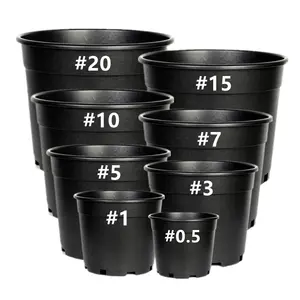
All categories
Featured selections
Trade Assurance
Buyer Central
Help Center
Get the app
Become a supplier

(11928 products available)


















































Large tree pots are the containers designed to hold trees and shrubs for urban landscaping and re-greening. They are also known as large tree planters. They come in different sizes and types. Below are some of the most common large tree pot types.
Plastic Large Tree Pots
Plastic large tree pots are lightweight, flexible, and shatter-resistant. They provide a smooth and polished look for the trees inside. Being affordable to produce, plastic large tree pots are the most commonly used in nurseries across the globe. They are easy to carry around. However, they have a few drawbacks. For one, they can become brittle when exposed to sunlight for a long time. Besides, they are not biodegradable. Throwing them away contributes to environmental pollution.
Ceramic Large Tree Pots
These large tree pots are made from clay and other natural materials. They are fired at a high temperature to make them more durable. Ceramic large tree pots are perfect for outdoor and indoor use. They can withstand extreme weather conditions. Besides, they have excellent water retention capabilities. However, ceramic large tree pots are expensive. They are also heavy, making them hard to move around.
Fiberglass Large Tree Pots
Large tree pots made from fiberglass are lightweight and robust. They can withstand UV rays and extreme temperatures. That makes them perfect for use in both outdoor and indoor settings. Moreover, fiberglass large tree pots are easy to clean and maintain. They have a smooth finish that adds to the aesthetic appeal of the pot. However, fiberglass large tree pots are costly. They are also hard to repair once damaged.
Metal Large Tree Pots
Metal large tree pots are made from aluminum, steel, or copper. They are durable and robust, making them ideal for heavy-duty use. Metal large tree pots have a modern and sleek design that adds to the decor of the space they are in. They are also resistant to rust and corrosion. On the downside, metal large tree pots can heat up quickly under the sun. They are also expensive and hard to insulate.
Wood Large Tree Pots
Wood large tree pots are aesthetically pleasing. They add a natural and rustic touch to the decor of a space. They have good insulation properties. However, wood large tree pots can crack and warp. They also require regular maintenance to prevent damage from water and pest invasion.
Materials
Large tree planters are made from different materials. Plastic and fiberglass are light and durable. They resist bad weather and are good for outdoor use. Metal planters, like steel or copper, give a modern look but need protection from rust. Ceramic and concrete planters are heavy and stable, ideal for big trees, but they may need special care to avoid cracking. Wood planters look natural but must be treated to withstand moisture. The choice of material affects the pot's look, weight, and how well it lasts in different environments.
Shape and Style
Large tree pots come in many shapes and styles to match different places. Round pots are classic and look smooth. Square and rectangular pots fit modern and organized spaces well. Tall, narrow pots suit vertical plants, while wide pots give enough room for roots. Ornamental edging adds a decorative touch. Textures like smooth, rustic, or patterned enrich the visual appeal. Planters can have themes, from sleek and contemporary to earthy and traditional. Choosing the right shape and style enhances the beauty of trees without affecting their health.
Drainage and Irrigation
Large tree pots need good drainage to keep plants healthy. Trees and plants don't like standing water as it can harm their roots. Most planters have holes at the bottom to let excess water out and prevent root rot. Some advanced planters have self-watering systems that supply water evenly. Good drainage is vital for tree health, and self-watering systems make caring for large plants easier, especially in places with strict watering rules.
Root Management
Large tree pots are designed with root control in mind. Some pots have root pruning features that stop roots from growing out of the planter box. This prevents roots from wrapping around and choking the plant. A well-managed root system keeps the tree healthy and stable. Trees with controlled roots grow better and live longer in their pots.
Weight Considerations
The weight of large tree pots is important for moving and supporting the plant. Materials like plastic and fiberglass are chosen for their lightness, even when the pot is big. A heavy pot can make it hard to change or damage places. The weight also affects the choice between a mobile and fixed planter. Keeping the weight in check helps keep the pot safe and makes caring for the tree easier.
Environmental Impact
The environmental effect of large tree pots is considered in their design. Producers aim for eco-friendly materials and methods to reduce waste. Some planters use recycled stuff or can be recycled later. The goal is to lessen the carbon footprint and make the planters safer for nature. Choosing green planters helps protect the environment while growing trees and plants.
Large tree pots for urban forestry
Large tree pots can be used in urban forestry programs. They allow for planting large trees in urban areas with limited space. Urban foresters can use these pots to grow trees in cities. They provide a way to increase urban greenery without needing more ground space.
Large tree pots for temporary tree storage
These pots can store trees temporarily during construction projects. They protect the trees and make relocating them later easier. Using large tree pots for temporary storage helps preserve valuable trees on construction sites.
Tree recovery programs with large tree pots
Tree recovery programs can use large tree pots to grow and rehabilitate native species. Such pots provide a controlled environment for growing trees until they are ready for replanting in their natural habitat. This use of large tree pots supports biodiversity and helps restore ecosystems.
Large tree pots for educational purposes
Schools and universities can use large tree pots to teach about horticulture and arboriculture. Students can learn how to care for trees and understand their biology. These pots provide a hands-on learning experience for future horticulturists and arborists.
Large tree pots for public art installations
Large tree pots can be canvases for public art projects. Artists can paint them or use them to display sculptures. These art-filled pots make urban spaces more attractive and integrate art into the community. They also inspire people to see trees as part of our culture.
Large tree pots in research facilities
Research institutions can use large tree pots to study tree species. Scientists can investigate how different trees respond to climate change or diseases. Large tree pots give researchers a way to control conditions and isolate variables in their experiments. This use advances scientific knowledge about trees.
Choose the right pot size:
The pot size should be large enough to accommodate the tree's current root system, with room for future growth. As a rule of thumb, the pot should be at least 2-3 times wider than the tree's root ball and deep enough to allow for 1.5-2 times the root ball depth. This will help prevent tree roots from growing into the large planter pot too quickly.
Consider the material:
Large tree pots are made from many different materials, each with its own advantages and disadvantages. For example, concrete pots are durable and heavy, which is great for stabilizing large trees, but they also tend to drain poorly, so good drainage is essential. Terracotta is porous and allows for air exchange but can dry out quickly. Plastic is lightweight and retains moisture well but can heat up quickly in the sun. Metal is modern and sleek but can conduct heat and cool rapidly. Choose a pot material that will suit the tree's needs and the climate.
Check for drainage:
Proper drainage is essential for maintaining tree health. Too much water in the pot can cause root rot and create an environment with low oxygen levels, which is harmful to trees. Make sure the pot has many drainage holes at the bottom. If it doesn't, consider drilling some or adding a free-draining material like gravel. For large tree planters without drainage holes, use a sub-irrigation system to ensure excess water is removed.
Think about mobility:
Large tree pots can be heavy, especially when filled with soil and a growing tree. If the pot will need to be moved, consider a lightweight material like plastic or composite. Adding casters or wheels to the bottom of the planter pot can also make it easier to relocate. For concrete or terracotta pots, straps or hoists may be necessary to lift and move them safely.
Plan for irrigation:
Keeping large tree pots consistently watered can be difficult, especially in hot weather. Consider using self-watering or wicking pots that provide a steady supply of moisture from a reservoir. Drip irrigation systems that slowly release water from a main line are another convenient option for large planters. This will help prevent overwatering or underwatering the tree, leading to stress and poor growth.
Q1: What are the benefits of using tree pots?
A1: Tree pots support trees' early growth stages and transplant readiness. They offer a controlled environment, promote healthy root development, and reduce transplant shock.
Q2: How can large tree pots help manage urban green spaces?
A2: Large tree planters for streets provide flexibility in planting design, space optimization, and easy relocation or reconfiguration of urban greenery. They solve space constraints and enhance urban forestry.
Q3: What materials are large tree pots made from?
A3: Large tree pots are usually made from durable materials like plastic, fiberglass, concrete, or metal to withstand outdoor conditions and support large root systems.
Q4: Can tree pots be moved once they are planted?
A4: Moving a planted tree from a pot can be hard and may risk the tree's health. It needs careful planning to ensure the tree's safety during relocation.
Q5: Do big tree pots get recycled?
A5: Many tree pots get recycled, especially those made from plastic and fiberglass. Some programs take back pots for reuse or recycling.